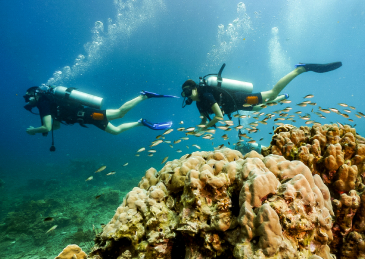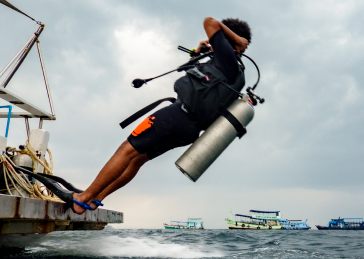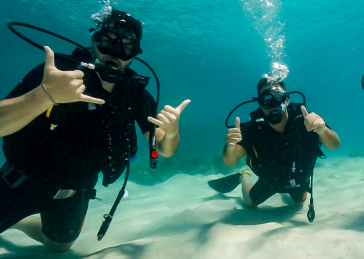Modified 9th June 2025
Pufferfish Koh Tao: The Charming Underwater Personalities You’ll Meet While Diving
The waters surrounding Koh Tao host an extraordinary cast of underwater characters that captivate divers from around the world. Among these marine personalities, the island’s pufferfish species stand out as some of the most charming and memorable encounters. With their bulbous bodies, perpetual “smiles,” and quirky behaviors, these fascinating fish have earned a special place in the hearts of both novice and experienced divers exploring this Thai diving paradise.
Each pufferfish species around Koh Tao possesses unique characteristics that make them remarkable underwater encounters. From the impressive Giant Puffer cruising reef edges to the friendly resident Porcupinefish “Steve” at the Junkyard dive site, these creatures showcase the incredible diversity and personality of vida marina in these tropical waters.
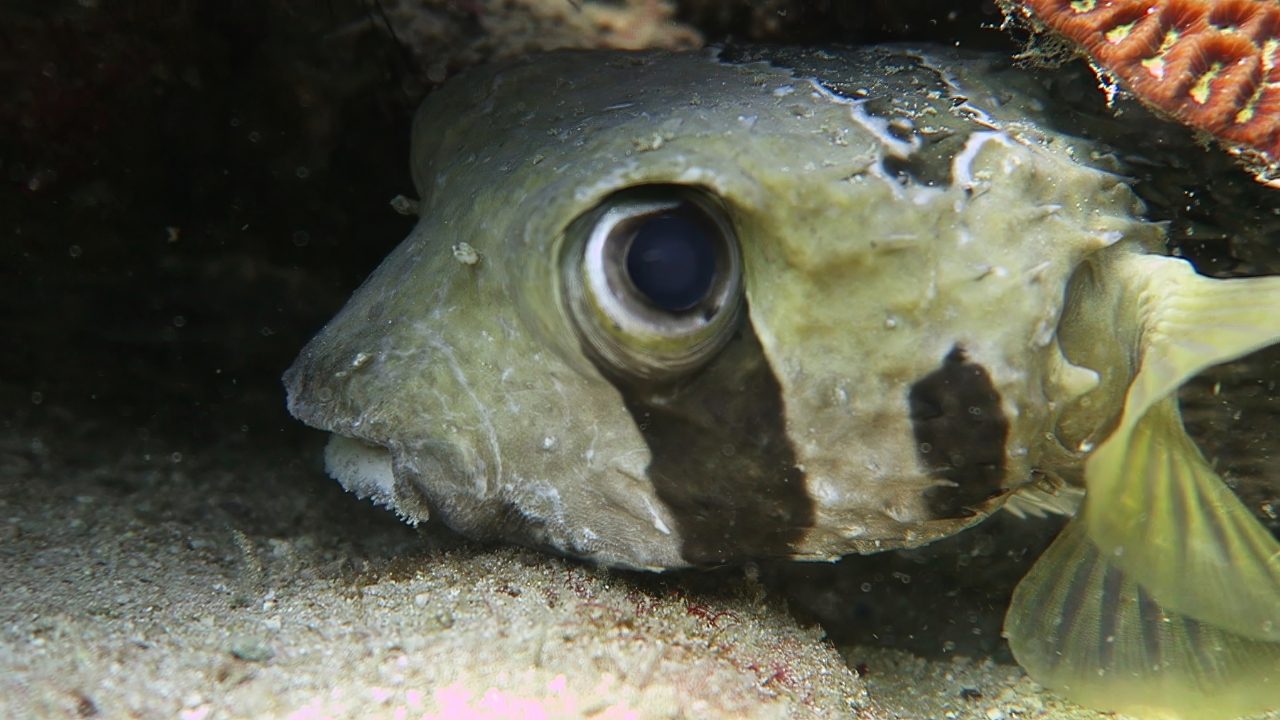
Interactive Pufferfish Species Identifier
What Pufferfish Did You Spot?
Use this tool to identify which pufferfish species you encountered during your Koh Tao dive:
Meet Koh Tao’s Pufferfish Species
The gentle giant of Koh Tao’s pufferfish family, easily recognized by its impressive size and star-like white spots covering a darker background.
Best spots: Twins, Mago Bay, White Rock – usually found cruising along reef edges and sandy areas.
The most iconic pufferfish species in Koh Tao, famous for both their spiky defensive capabilities and the celebrity resident “Steve” at the Junkyard.
Best spots: The Junkyard (home to Steve), White Rock, night dives around most sites.
The most endearing species with its distinctive “pouty” seal-like face and relatively rare appearances around Koh Tao’s dive sites.
Best spots: Japanese Gardens, Twins, Shark Island – prefer shallow to mid-depth areas with healthy coral growth.
No discussion of pufferfish Koh Tao would be complete without introducing “Steve,” the remarkable Porcupinefish who has become a local celebrity at the Junkyard dive site. Unlike his more cautious relatives, Steve has developed an extraordinary comfort level with human visitors, often approaching divers with genuine curiosity rather than maintaining the typical defensive distance.
Named by local dive guides around 2017-2018, Steve has been observed growing from a juvenile to a mature adult Porcupinefish over several years. His friendly behavior isn’t the result of feeding or handling – practices strongly discouraged by responsible dive operations – but rather represents a natural individual personality trait combined with learned comfort around respectful divers.
Steve’s Territory: The Junkyard artificial reef site on Koh Tao’s western side, created from purposely placed structures and items transformed into thriving marine habitats.
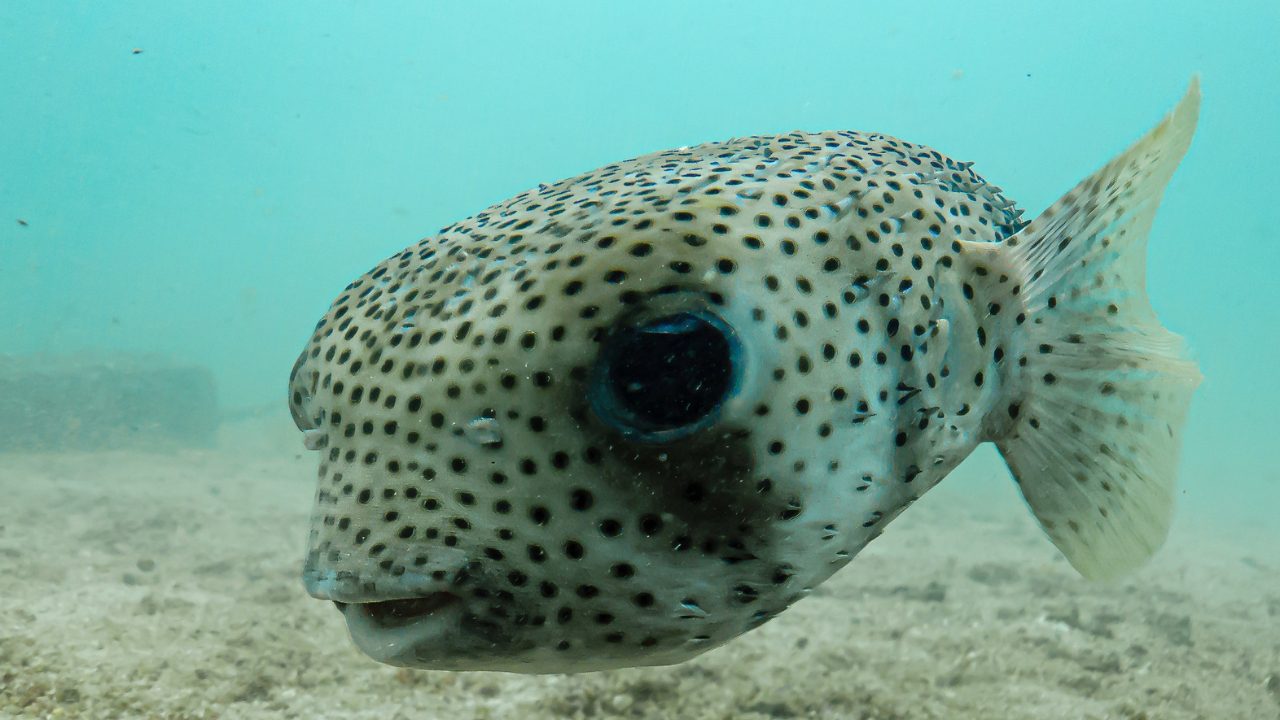
Where to Find Pufferfish Around Koh Tao
| Dive Site | Pufferfish Species | Best Time | Notes |
|---|---|---|---|
| The Junkyard | Porcupinefish (Steve!) | All day | Almost guaranteed sightings, artificial reef environment |
| Japanese Gardens | All three species | Morning/afternoon | Beginner-friendly, shallow site perfect for Seal-faced Puffers |
| Gemelos | Giant Puffer, Seal-faced | Early morning/late afternoon | Giant Puffers cruise between the twin pinnacles |
| White Rock | All three species | Variable | Porcupinefish rest in crevices during day |
| Isla del Tiburón | Seal-faced Pufferfish | Daytime | Shallow depth suitable for diving and snorkeling |
| Night Dives | Porcupinefish (active) | After sunset | Best time to observe natural foraging behavior |
All pufferfish species contain tetrodotoxin, one of nature’s most potent neurotoxins, with no known antidote. While this poses no danger to divers who observe these creatures respectfully, it reinforces the absolute importance of the “look but don’t touch” principle. The toxin is primarily concentrated in internal organs but is also present in skin. Never attempt to handle, feed, or stress these fish into inflating – they can only “puff up” 3-4 times before potentially fatal stress occurs.
Responsible Interaction Guidelines
These guidelines help ensure both your safety and the wellbeing of these remarkable creatures:
- Maintain Respectful Distance: Allow pufferfish to approach on their terms rather than pursuing them
- Never Touch or Feed: Besides toxicity risks, handling causes stress and damages protective mucus coatings
- Control Your Buoyancy: Poor buoyancy control damages reef habitats critical to pufferfish survival
- Limit Photography: Take photos without flash and avoid excessive attempts to “pose” the fish
- Report Sightings: Many dive centers participate in monitoring programs where regular sightings help track population health
- Choose Responsible Operators: Support dive centers that prioritize marine conservation and proper interaction protocols
Conservation Challenges and Threats
Despite their toxic defenses, pufferfish face numerous challenges in Koh Tao’s waters and throughout their range:
- Habitat Degradation: Coral reef decline due to climate change, pollution, and physical damage impacts specialized habitats
- Aquarium Trade: Their charismatic appearance makes them targets for collection, often with high mortality rates in captivity
- Fishing Pressure: Incidental capture in fishing gear and targeted fishing in other regions affect populations
- Tourism Impacts: Inappropriate interactions can stress animals and alter natural behaviors
Local dive operators and conservation organizations promote responsible interaction guidelines that help protect these charismatic creatures while allowing sustainable tourism encounters.
Ready to encounter Koh Tao’s charming underwater puffers?
La Bombona Diving offers expert-guided experiences to the best pufferfish spotting locations around Koh Tao, combining marine life encounters with comprehensive safety and conservation education.
- Expert guides who know individual fish like Steve
- Visits to prime pufferfish locations including The Junkyard
- Comprehensive marine life identification training
- Conservation-focused diving practices
- Small group sizes for better wildlife encounters
- Photography guidance for memorable pufferfish shots
- Both day and night diving opportunities
- Beginner-friendly sites like Japanese Gardens included
Start with our Try Dive program to meet Koh Tao’s pufferfish, or get certified to explore all the best sites!
Book Your Pufferfish Adventure – Try Dive ฿2,500Full day experience | 1-2 dives | All equipment included
Frequently Asked Questions About Pufferfish Koh Tao
Bucea con LBD: tu puerta a la exploración submarina
Whether you’re a curious beginner or a seasoned pro, our school is your portal to the wonders of scuba diving. Join us into the world beneath the waves.
¿LISTO PARA EMPEZAR?
Consulta nuestros cursos de buceo en Koh Tao
